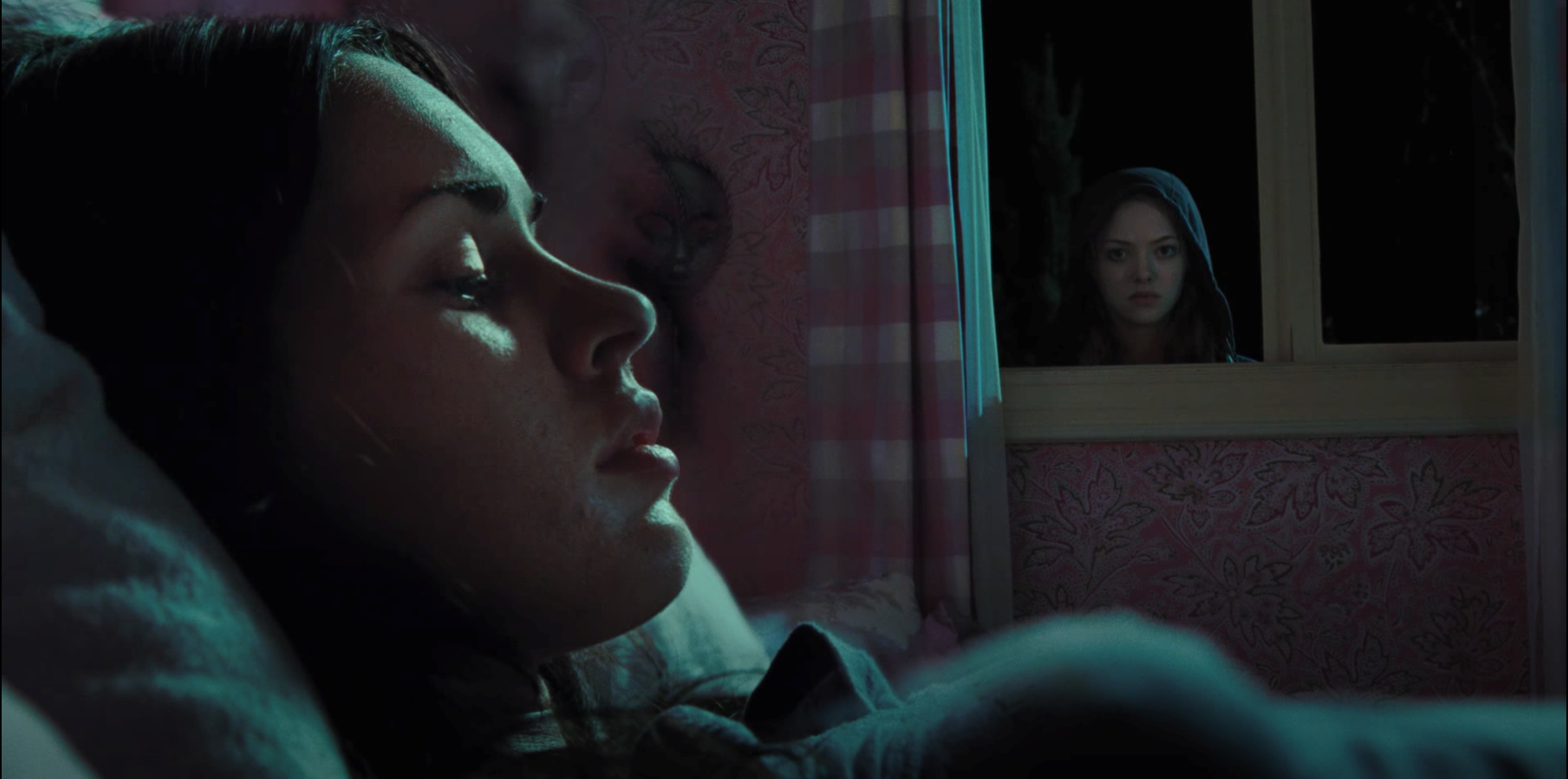[Pride 2020] Hell Is A Teenager Girl: The Lesbian Feminist Gaze In Jennifer's Body
Most feminist film theorists agree that their field was really kicked off in 1975, when Laura Mulvey pointed out that most classical narrative cinema was dominated by what straight, cisgender men wanted to see on screen. It turns out that most men like to see a lot of women’s bodies, but they want films to show them those bodies without ever making them deal with women’s brains or substance. Mulvey is a psychoanalytic film theorist who did no scientific research into whether any of this was true, but her article caused a stir, with most readers recognizing the truth of it. When it comes to watching movies, women have noticed that privileged men tend to feel pretty entitled to an easy, pleasurable viewing experience.
Jennifer’s Body was marketed as catering to exactly this kind of visual pleasure, which is now often referred to as “the male gaze.” It was called “Twilight for boys,” and many of the promotional materials relied on the widespread knowledge that Megan Fox, who plays the titular Jennifer, is, well, hot as hell. But when the film came out, the audience (the group of teenage boys to whom it had been advertised) was enormously disappointed by the actual plot.
The movie opens with a scene of Anita (Amanda Seyfried, referred to throughout as “Needy”) appearing at Jennifer’s window, watching without being seen. This is followed by the first lines, spoken by Needy as voiceover: “Hell is a teenage girl.” The voiceover goes on to describe the unlikely friendship between the two before introducing the pivotal scene, in which the friends attend an indie show at the local bar. As Needy watches her friend become entranced by the band, the bar starts to burn down, and in the chaos that follows, the band members seduce Jennifer into the back of their van. When she returns to Needy, she’s violently different. Instead of chasing boys for fun, she has become possessed by a demon and starts to pursue them for food. Through research, Needy determines that the band members tried to sacrifice Jennifer as a virgin to seal their deal with a demon. Because she wasn’t actually a virgin, though, she instead takes on the demon’s soul and gets, you know, all up in some boys’ guts.
Some reviewers have connected the movie to the #MeToo movement because of its apparent revenge arc. This explanation, though, misses both the point of #MeToo and the point of Jennifer’s Body. First of all, #MeToo denotes a really time-specific way of talking about sexual assault in specifically the film and other media industries on social media. Second, the hashtag and the movie have extremely different relationships to revenge. And third, Jennifer’s Body isn’t only a feminist text–it’s also a lesbian statement.
It’s easy to see how the error could be made. After all, survivors on twitter took to exposing their assaulters in the same way that Jennifer exposes random classmates’ guts to oxygen. However, Jennifer doesn’t just go after the boys who tried to sacrifice her; she goes after boys, period. And even disregarding the best friends’ occasional kisses and handholding, the way that the gaze is deployed throughout the film is all about women looking at women, and men mainly existing to be a great source of protein.
Take that first scene, in which Needy appears at the window to peek in at Jennifer. The scene is set up to give us the impression of classical narrative techniques that Mulvey talks about, such as the fragmentation of the woman’s body and the voyeuristic separation of the viewer from the female character. We get a few frames of Jennifer’s lips as she chews on her hair between moving shots of the camera drawing closer to the window, clearly the perspective of a voyeur. But then, instead of the classic male Peeping Tom, who should appear at the window but sweet Needy? From the very start, it’s implied that women have taken over as the viewers of other women as objects of desire.
Throughout the rest of the movie, there are multiple implications that Needy and Jennifer like each other more than they like their respective male partners. In another early scene, of Needy watching Jennifer execute a cheerleading routine, a classmate accuses the two of being romantically involved. Chip, Needy’s boyfriend, is frustrated when Needy decides to accompany or investigate Jennifer rather than spending the night with him. And when she does finally sleep over, their scene together is crosscut with a sequence of Jennifer luring a local goth boy into an abandoned house and ravishing him in a more literal sense.
This is the movie’s seamless way of bringing home the point that the girls’ performances of sex acts on their men are basically the same as cannibalistic attacks. By switching quickly between Needy’s steamy encounter and Jennifer’s murderous one, the editing shows the audience that these two things are just different sides of the same coin. Jennifer, seducing boys, has always been destroying them for her own gain. Though the boys think they’re the ones “taking” Jennifer, it’s actually she who has had all the power, not just as a demon, but also before, as a teenage girl.
The idea that Jennifer and Needy have the most meaningful romantic relationship in the movie is not mine or new, and is probably best outlined in the Anatomy of a Scream article “In Defence of That Kiss: Jennifer’s Body is the Queer Love Story I’ve Always Wanted.” The article also touches on the movie’s lesbian feminist slant, the way that Jennifer uses her sexuality as a tool to gain power over her male classmates. The purpose of this review is to affirm that a close reading of the film alongside established feminist film theory supports what many sapphic viewers have sensed since they first saw the film: that teenage girls are far more powerful than is widely acknowledged, and that men should be a little more wary.
The finishing touches on this message come from the deception that Jennifer pulls on the boys from Low Shoulder, who try to sacrifice her for the success of their band. They think she’s a virgin who will die as a result of the ceremony. However, as Needy’s research reveals much later in the film, Jennifer’s non-virginity is what has kept her alive, or at least undead, and what enables her to continue her maneating practices with minimal changes to her routine. This is actually the same trick that the marketing team has pulled on the teenage boys to whom it advertised, luring them in with the promise of sexy women, catfights, and maybe some women’s bodies in pieces.
After all, the male gaze gets all its power from being able to slice and dice the image of the woman, manipulating the picture of femininity for the pleasure of the male spectator, and never acknowledging the real person who was the subject of that picture. Instead, they are confronted by a deceptive and cunning main female character who cuts up and consumes the men in her life, finding her most fulfilling and complex relationship with her best girlfriend. If Jennifer’s Body wasn’t a box office success in 2009, it’s because the boys who went to see it were unable to wrap their heads around how the filmic conventions that had always brought them sadistic pleasure were now being used to lure them in and eat them alive.


![[Pride 2020] Hell Is A Teenager Girl: The Lesbian Feminist Gaze In Jennifer's Body](https://images.squarespace-cdn.com/content/v1/5b39608d75f9eef54c62c3f0/1591802309120-Z53PWDR0LQWCRZTQLHBE/jen-body.jpg)





![[Pride 2020] For Sean, From My POV As A Horror Fan](https://images.squarespace-cdn.com/content/v1/5b39608d75f9eef54c62c3f0/1593484114370-B09RZEZ6FWKW8TFIG0NA/Sean%2Bpic%2B1.jpg)
![[Pride 2020] Finding Jennifer; Or, How I Learned to Stop Hating Jennifer's Body](https://images.squarespace-cdn.com/content/v1/5b39608d75f9eef54c62c3f0/1593483718013-3AP23VJDN9V0MMA6V3DU/51d02d6fb673bec72cb41a366c86bb39.jpg)
![[Pride 2020] Good Manners Deconstructs Class and Racial Disparities in Brazil](https://images.squarespace-cdn.com/content/v1/5b39608d75f9eef54c62c3f0/1593398398356-6QRX0G4PK4S87TKTMF0T/1270796_goodmanners_432313.jpg)
![[Pride 2020] The Power Of Difference In Hellraiser's Queerness](https://images.squarespace-cdn.com/content/v1/5b39608d75f9eef54c62c3f0/1593397752213-22GFO5I1QW8I220F5MZM/hellraiser_hed.jpg)
![[Pride 2020] Love, Trauma And Horror](https://images.squarespace-cdn.com/content/v1/5b39608d75f9eef54c62c3f0/1593323224833-38FH4ANZTM88LXS5HG5M/Hush.jpeg)
![[Pride 2020] A Lance in the Throat: Scary Heteros in Almodóvar’s “Matador”](https://images.squarespace-cdn.com/content/v1/5b39608d75f9eef54c62c3f0/1593322407370-GXK7L0BP0D7QNTN1FFPE/ede3ca1c-1165-11e8-9ac6-bbf931a203ee4.jpeg)
![[Pride 2020] The Mischa Project](https://images.squarespace-cdn.com/content/v1/5b39608d75f9eef54c62c3f0/1593231688339-UJSAXF4NN6K1ETEK9EBS/41000240.jpg)
![[Pride 2020] Another Cheater](https://images.squarespace-cdn.com/content/v1/5b39608d75f9eef54c62c3f0/1593230510967-BTX8BAR5VDNNJO58OW7V/knife.jpg)
![[Pride 2020] Extreme Horror And Queer Affirmation In Martyrs](https://images.squarespace-cdn.com/content/v1/5b39608d75f9eef54c62c3f0/1593140634217-BSFPGD1GVAV693B06Q1X/film_martyrs.jpg)
![[Pride 2020] "And I Still Don't Even Know How I Even Survive": Navigating Hard Times With Happy Death Day 2U](https://images.squarespace-cdn.com/content/v1/5b39608d75f9eef54c62c3f0/1593140172444-2JM3W35YYCJ9803EETB7/maxresdefault.jpg)
![[Pride 2020] Life Against The Dark: Growing Up And Coming Out With Hill House's Theodora](https://images.squarespace-cdn.com/content/v1/5b39608d75f9eef54c62c3f0/1593047800584-A79Y39E6S4OIURNI63GS/IMG_1438.JPG)
![[Pride 2020] Outside Of Laramie: Joy Ride (2001) As Gay Panic Horror](https://images.squarespace-cdn.com/content/v1/5b39608d75f9eef54c62c3f0/1593046627243-BQQZOWPMVE2TZKCYT90Z/519yvHX-bLL._AC_.jpg)
![[Pride 2020] A Bumpy Road Of Queer Gothic Resistance From The Old Dark House To The Rocky Horror Picture Show](https://images.squarespace-cdn.com/content/v1/5b39608d75f9eef54c62c3f0/1592959865412-WZQ8BTV28SHJX1WHEYK5/rocky-horror-sequel-01.jpg)
![[Pride 2020] Why Bisexual Representation In Jennifer's Body Matters](https://images.squarespace-cdn.com/content/v1/5b39608d75f9eef54c62c3f0/1592959284705-3SMVYNT4ZMWN0QADZJDB/jennifers-body.jpg)
![[Pride 2020] A Tribute To Kevin Williamson](https://images.squarespace-cdn.com/content/v1/5b39608d75f9eef54c62c3f0/1592881451514-Y4OPAHSXUI63FH3T7TB2/lockwood_williamson2.jpg)
![[Pride 2020] The Power Of The Trans Monster In Bit And Switch](https://images.squarespace-cdn.com/content/v1/5b39608d75f9eef54c62c3f0/1592880971405-NFCCXW50AVB1PIPZQZVW/MV5BOWE0YjFhYTUtMWE2Zi00OWJkLTg2MzItY2VlYzUxMWE4YTM3XkEyXkFqcGdeQXVyMjE5MzYzNjU%40._V1_.jpg)
![[Pride 2020] Passive Homophobia And Its Effect On Their LGBTQIA+ Audience](https://images.squarespace-cdn.com/content/v1/5b39608d75f9eef54c62c3f0/1592794014122-9YU0ZSHP1UUC4AZS2LSL/kelly-freddyvsjason1.jpg)
![[Pride 2020] There's A Monster At The End Of This Essay](https://images.squarespace-cdn.com/content/v1/5b39608d75f9eef54c62c3f0/1592793247165-0IRK6TCXUYLCYN41EGH5/sesame-street-the-monster-at-the-end-of-this-book-9780794440237.in01.jpg)
![[Pride 2020] Bisexuality in Genre: How Catherine Tramell Warped Sexuality Forever](https://images.squarespace-cdn.com/content/v1/5b39608d75f9eef54c62c3f0/1592708306869-A25JKBJ9WESFNUM9EFZJ/6bee9e40b42062fb5a4456c27a31b2e0.jpg)
![[Pride 2020] How Evil Dead 2 Helped A Trans Girl Find Herself](https://images.squarespace-cdn.com/content/v1/5b39608d75f9eef54c62c3f0/1592707596758-2ANPLJK8JEY9XX3HTCH4/0a1ccb15-21f6-4dc9-b1b6-635c40e0046e_1.e6d75d0b581b65da70719cdba2fd46d5.jpeg)
![[Pride 2020] The Spirit Of Thomas Carroll](https://images.squarespace-cdn.com/content/v1/5b39608d75f9eef54c62c3f0/1592624295460-BJ42D5K1DFKXCFRKN7KI/pexels-photo-1671325.jpeg)
![[Pride 2020] Sickos Never Scare Me](https://images.squarespace-cdn.com/content/v1/5b39608d75f9eef54c62c3f0/1592543280046-WRDU1JSIN3JB4W7OJUGB/catwoman-700x500.jpg)
![[Pride 2020] Lovecraft, Horror And Questioning Sexuality](https://images.squarespace-cdn.com/content/v1/5b39608d75f9eef54c62c3f0/1592542591836-SJXZY6P0OZUKZY8R1F6E/cthulhupostbig.jpg)
![[Pride 2020] In Defense Of And Against Richie's Secret In It: Chapter 2](https://images.squarespace-cdn.com/content/v1/5b39608d75f9eef54c62c3f0/1592457692112-AKTBKSAQ9GSR1DI8HIX9/5ca22ee726a592e1c6c4b42b379af52b9d6f09f5.jpg)
![[Pride 2020] Bloodthirsty Villains And Homicidal Maniacs...But Make It Gay](https://images.squarespace-cdn.com/content/v1/5b39608d75f9eef54c62c3f0/1592457031919-F7C0J9H77JJQ4H0S69KT/630e2b1afaaafb06d9728b9627532756.jpg)
![[Pride 2020] A Life Changing Excision](https://images.squarespace-cdn.com/content/v1/5b39608d75f9eef54c62c3f0/1592359171589-LWRXA6B3UHFSBL4WXIB4/Excision-Pic-2-800x330.png)
![[Pride 2020] Drag Me to Hell: An Incomplete History of the Intersection of Drag and Horror](https://images.squarespace-cdn.com/content/v1/5b39608d75f9eef54c62c3f0/1592358005266-TM3GTK2Q0UHANROZKE29/Nightclub+of+the+Living+Dead.png)
![[Pride 2020] From Villains To Heroes: Imperfect Women In Horror](https://images.squarespace-cdn.com/content/v1/5b39608d75f9eef54c62c3f0/1592267521002-M5YENUAM359R1LFXRKDK/intro-1514398906.jpg)
![[Pride 2020] "I always thought the only alien in this high school was me" - Navigating Identity In The Faculty](https://images.squarespace-cdn.com/content/v1/5b39608d75f9eef54c62c3f0/1592266793030-0M18Z90CRBEF2LDW3178/5142466d6f362f188229058788d9af42.jpg)
![[Pride 2020] My Sinister San Francisco](https://images.squarespace-cdn.com/content/v1/5b39608d75f9eef54c62c3f0/1591842007981-NSB2G0MI7R583XC7UWRX/title.png)
![[Pride 2020] My Mother's Guide to Video](https://images.squarespace-cdn.com/content/v1/5b39608d75f9eef54c62c3f0/1591801661141-FCBVTS7RU2H9FS3ICHK9/1.jpg)